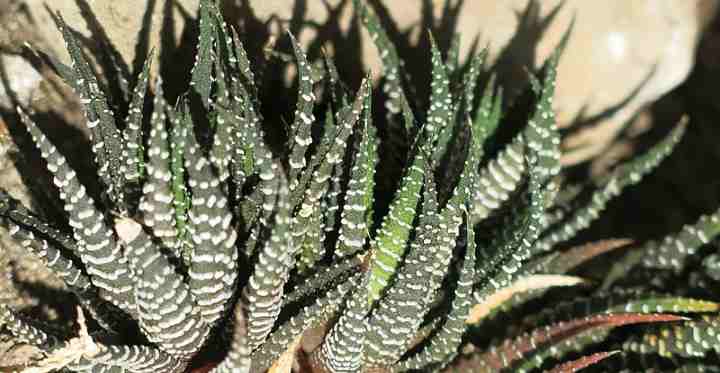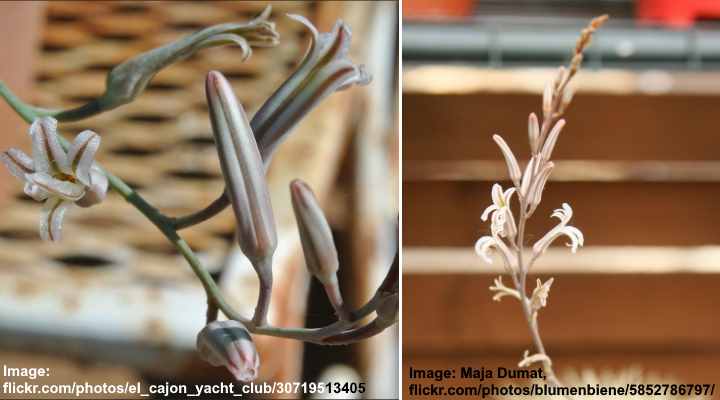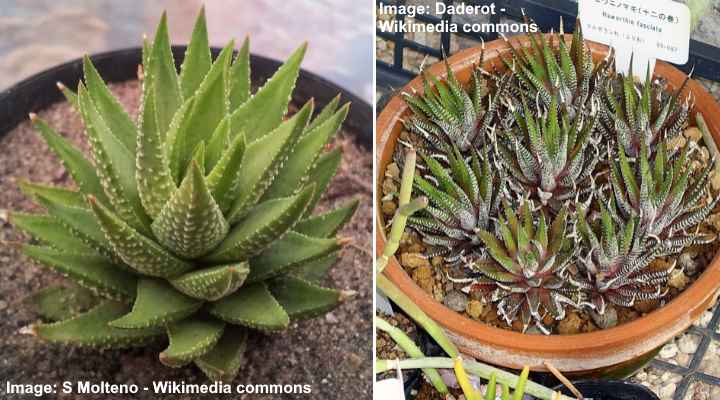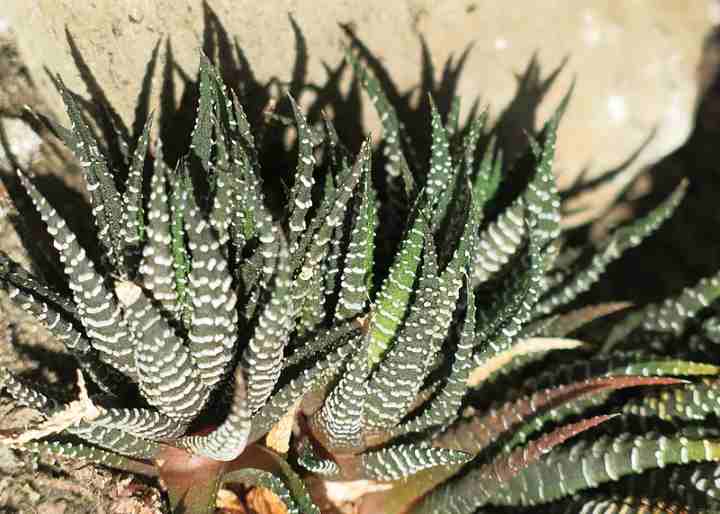Haworthia Fasciata (Zebra Haworthia or Zebra Plant): Succulent Care and Growing Guide

The Haworthia fasciata, also called “Zebra Plant” or zebra Haworthia, is a small-growing succulent with a spiky appearance. The common name for this fleshy succulent plant comes from its bumpy white zebra-like markings on the leaves. Although Haworthia fasciata “zebra plant” looks like small cacti or aloe (it is commonly called “zebra cactus”), it is a true type of succulent.
How to care for Zebra Haworthia succulent: To care for Haworthia fasciata “Zebra Plant” grow it in partial sun and plant it in a well-draining cactus potting soil. The Zebra cactus needs average humidity. Water the zebra Haworthia as often as the soil dries. Grow in temperatures between 65°F and 80°F (18°C – 26°C). Fertilize occasionally during the growing season.
Haworthia fasciata “Zebra Plant” is often mistaken for Haworthia attenuata. However, the inner leaves of Haworthia attenuata have bumps, whereas the leaves of Haworthia fasciata “Zebra Plant” are smooth. Besides, Haworth fasciata has fatter leaves than Haworthia attenuata that tend to curve inward more.

Haworthia fasciata (upper picture) vs Haworthia attenuata (lower picture)
Compared to some other species of succulents or cacti, Haworthia fasciata “Zebra Plants” have a relatively low growth rate. This slow-growing fleshy-leaved Haworthia plant only grows to about 4” (10 cm) high. Its stout triangular-shaped leaves grow upward in a rosette pattern. And the horizontal white stripes give the zebra succulent a striking appearance.
Haworthia fasciata has the newer botanical name Haworthiopsis fasciata. The small fleshy succulents are native to South Africa, where they grow in rock crevices in hot arid climates. In the wild, Haworthia Zebra plants are close to extinction from over-collecting. As a houseplant, “Zebra” succulents are easy to grow and look after.
This article is a complete guide to Haworthia fasciata “Zebra Plant” care. At the end of the article, you’ll find out how to resolve issues when growing “Zebra Plants” indoors.
Haworthia Fasciata “Zebra Plant” Flowers

Haworthia fasciata can flower indoors if grown in optimal conditions
“Zebra” Haworthia is a type of flowering succulent with dainty white flowers. The long, slender Haworthia flowers appear on the end of long stalks, usually in summer. So, in their native habitat, these succulents flower in October or November. However, they require optimal growing conditions to flower indoors.
Haworthia plants—unlike some species of succulents—don’t die after flowering. The Haworthia plant is a monocot type, and not monocarpic (plants that flower once before dying). If you are fortunate enough to have a flowering “Zebra Plant,” it should bloom annually for many years.
How to Care for Haworthia Fasciata “Zebra Plant”
Haworthia fasciata is easy to care for at home. The most crucial care requirement is to avoid letting the potting soil become too soggy or waterlogged. So, keep the mini zebra plant in partial sunshine and water occasionally—only when the soil is dry.
Let’s look in more detail at how to care for this striped “zebra” succulent.
Haworthia Fasciata “Zebra Plant” Light Requirements

Zebra Haworthia succulents grow well in a bright indirect light
Haworthia fasciata “Zebra Plant” grows best in partial sun. When grown outdoors Haworthia fasciata thrives in partially shaded areas that get 4-6 hours of sunlight in the morning. When grown indoors, place zebra plant on a window seal where it receives bright indirect light in the morning. But make sure this location is shaded in the afternoon when the sunlight is more intense.
During summer, too much direct sunlight could cause the Haworthia fasciata plant’s foliage to burn. So, although “Zebra Plants” are sun-loving, they need some protection from direct sunlight shining through a window. You should ensure this plant is protected from direct sun in the afternoon, as it can cause the leaves to scorch.
Although plants such as cacti and succulents are known for growing in strong sunlight, Haworthias adapt well to partial shade. So, you can grow these succulent plants indoors under artificial light. Their small compact growth habit and ability to thrive in partially shaded areas make “Zebra” succulents excellent plants for tabletops, on shelves, or as part of an indoor succulent garden.
How Often to Water Haworthia Fasciata “Zebra Plant”

“Zebra” Haworthia succulents only need watering when the soil dries out
Water Haworthia fasciata “Zebra plant” as often as the soil dries out. During spring and summer, you may only need to water the “Zebra plant” every two or three weeks. Or, if it’s very hot—weekly. In winter, “Zebra Plants” can go for many weeks without water.
Rather than have a set watering schedule, use soil and leaf growth as your guide for when to water.
How can you tell when your “Zebra Plant” needs watering? The first sign—the soil should be almost parched. Haworthia plants are quite tolerant of drought. So, you don’t have to worry about under-watering “Zebra Plants” as they store moisture in their fleshy leaves. The second sign—when their leaves start to curl.
To water a Haworthia fasciata plant, pour plenty of water in the soil until it drains out the pot’s bottom. Deep watering helps nourish and hydrate the roots. This succulent plant watering technique also allows the roots to draw up enough moisture to make the triangular leaves plump-looking.
When it comes to watering “Zebra Plants,” water them occasionally, but thoroughly. Several factors can affect how often you need to water Haworthia Zebras. These are:
- Sunlight—Plenty of sunlight will cause moisture to evaporate faster than when grown in the shade. A “Zebra Plant” will need watering more frequently when growing in full sun than in partial shade.
- Seasons—Although “Zebra” Haworthia is a slow-growing plant, it needs watering more often in spring and summer. In winter, when growth stops, you hardly ever need to water the plant.
- Type of pot—Moisture evaporates faster from clay, unglazed pots than from plastic or ceramic ones. Clay pots are the best type for succulents and cacti as the soil dries faster. This means that you’ll have to water Haworthias more frequently when they are growing in terracotta pots.
The Best Type of Soil for Haworthia Fasciata “Zebra Plant”

To care properly for your striped zebra Haworthia, make sure to plant it in a well-draining soil
Zebra Haworthia needs sandy, loamy soil that has excellent drainage. The best type of soil for Haworthias is a cactus potting mix. To make an ideal growing soil yourself, mix one-part potting soil, one-part coarse sand, and one-part perlite to increase drainage.
The growing medium for Zebra Haworthia must allow water to flow freely. The quickest way to kill a Haworthia succulent is to overwater it or let the roots sit in damp soil. The ideal potting soil needs time to dry out between watering.
If you need to create an aerated type of soil for “Zebra Plants,” there are a few ingredients you can add to a cactus potting mix. These are:
- Perlite
- Aquarium gravel
- Poultry grit
- Horticultural pumice
- Vermiculite
- Bits of activated charcoal
Temperature Requirements to Grow Zebra Haworthia
Haworthia fasciata “Zebra Plants” thrive in a temperature range of 65°F to 80°F (18°C – 26°C). Average room temperatures—as long as they don’t fluctuate rapidly—are perfect for growing Haworthia plants. Haworthia “Zebra” minimum temperature is 50°F (10°C), although they are cold hardy to 40°F (4°C).
When growing “Zebra” Haworthia plants indoors, try to keep them in warmer temperatures to thrive. During spring, summer, and fall, temperatures above 70°F (21°C) are ideal. In winter, place the striped “Zebra” succulent in a cool, unheated room. The cold temperatures give the plant time to rest.
Growing outdoors, Haworthiopsis fasciata “Zebra Plant” grows in USDA zones 9 to 11. If you live in colder climates, you can take your zebra plant pots outside during the summer. Place in partial sun in your garden where it gets the morning sun. When the nighttime temperature drops below 55°F (12°C), bring the small succulents back indoors.
Humidity for Haworthia Fasciata “Zebra Plant”
Zebra Haworthia plants don’t have any particular humidity needs. They grow fine in dry air, and average household humidity is perfect for healthy growth. While “Zebra Plants” don’t require humid conditions, they need good air circulation. So, keep the plants in a place that has proper ventilation and air movement.
There are three reasons why Haworthia fasciata plants need proper ventilation. These are:
- Ventilation during the night helps with photosynthesis as the succulents collect carbon dioxide.
- Adequate air circulation helps cool down succulents and cacti when growing under intense sunlight.
- Proper ventilation helps excess water evaporate from the soil after watering.
How to Fertilize Haworthia Fasciata “Zebra Plant”
Haworthia fasciata “Zebra Plants” don’t require a lot of fertilizer. To feed a Haworthia plant, use a balanced fertilizer for cacti. Mix the solution to half-strength, and fertilize your Haworthia fasciata two or three times in the growing season. Species of Haworthia are succulents that grow slowly and aren’t heavy feeders.
Like most houseplants, Haworthia succulents go into dormancy in winter. During this time, you should hold off feeding “Zebra Plants.” Also, don’t water the plants in winter if there are any signs of moisture in the soil.
Related: The Best Fertilizers for Indoor Plants
Haworthia Fasciata “Zebra Plant” Growth Rate
Haworthia fasciata is a type of slow-growing succulent plant. These succulents take many years to grow to their maximum height of 4” to 8” (10 – 20 cm). With the proper care, indoor zebra succulents will grow for many years.
The thick, dark-green fibrous leaves with brilliant white stripes will grow to become an attractive potted plant. If you get the growing conditions just right, its healthy growth will also produce flowers on the end of long stems.
Haworthia Fasciata “Zebra Plant” Propagation
“Zebra” Haworthia can be propagated by offsets and leaves. To propagate Haworthia fasciata “Zebra Plants” by offsets, remove the offsets or “pups” that grow around the base of the mother plant with a sharp clean knife. Allow the “wound” to dry for a few days. Then, plant the Haworthia fasciata in a pot with a cactus potting mix.
After a week, give the plant a deep watering. Care for the Haworthia fasciata as you would care for the mother plant.
To propagate “Zebra” Haworthia by leaf cutting, remove a healthy leaf with a sterile sharp knife from the main plant. Make sure to remove the whole leaf. Allow the “wound” to dry for several days and place the Haworthia fasciata in a well-draining soil. Avoid over-watering and water only when the soil has dried completely. The leaf will grow roots and develop into a new plant.
After propagation, it’s crucial to avoid over-watering. The base of the cut plant leaves can be sensitive to moisture. If you’re not careful, root rot can quickly develop and kill the small, growing succulent.
Do Haworthia fasciata “Zebra Plant” Require Repotting?
“Zebra” Haworthia plants rarely require repotting. The plant’s slow growth means that “Zebra Plants” seldom become rootbound. The reasons to repot a Haworthia Zebra are to separate offshoots for propagation. Or, you could choose to repot the zebra succulent to refresh the potting soil.
To repot a “Zebra Plant,” remove the succulent from the pot. Separate any offshoots with a sharp, sterile knife. Check the roots for any signs of disease, such as brown, mushy roots. Clean out the pot and fill it three-quarters full with cactus potting soil. Plant the Haworthia succulent and fill the rest of the space with soil.
If your compact succulent has outgrown its original container, choose a new pot that’s one to two sizes larger.
Just make sure that the pot has a few drainage holes in the bottom. These holes are necessary to allow water to drain quickly and prevent the roots from getting waterlogged.
How to Prune Haworthia Fasciata “Zebra Plant”
It’s not necessary to prune “Zebra Plants.” The succulent doesn’t grow fast, and like many aloes, cacti, and other succulent plants, pruning doesn’t affect growth. The only time you need to trim leaves is if they die or you want to propagate from leaf cuttings.
Pests Affecting Haworthia Fasciata “Zebra Plant” Growth
The most common houseplant pests affecting “Zebra” fasciata are spider mites, mealybugs, and scale insects. These plant-destroying “bugs” can live unnoticed in the dark crevices near the plant’s base. In time, scale, mealybugs, and spider mites can weaken the plant’s growth, making it susceptible to disease.
Here are the most common signs that Haworthia fasciata has pests:
- Spider mites—Look for webbing between the fleshy succulent leaves. Unless the infestation is extensive, it’s tough to see spider mites on succulents.
- Scale insects—These nasty creatures stick to succulent’s leaves, feeding on the plant’s juices. Scale pests usually look like unusual growth on the leaves. The insects typically don’t move and stick to one place.
- Mealybugs—You can spot signs of mealybugs by a white, cottony-wool like substance on the succulent leaves. You may also see the tiny white fuzzy bugs crawling on leaves.
Please read this article on how to get rid of common houseplant pests naturally. In the article, you’ll find how to eradicate mites, bugs, and insects from succulents.
Diseases Affecting Haworthia Fasciata “Zebra Plant” Growth
Root rot is the most common disease to afflict “Zebra Plants.” Over-watering your succulent plant causes roots to rot, decay, and become mushy. In time root rot can spread to the “Zebra” fasciata stem, eventually killing the plant.
It’s easy to prevent root rot in Haworthia fasciata by watering your succulents properly. Always wait until the soil is dry before hydrating. Then, when you water the plant, drench the soil and allow excess water to drip out.
If your Haworthia “Zebra Plant” shows signs of root rot, repot it in fresh, sterile potting soil. Make sure the new growing medium is aerated and loose so that moisture evaporates quickly, and roots don’t stay overly-damp.
Related: How to Care for Succulents: Growing Succulents and Keeping Them Alive
Are Haworthia Fasciata “Zebra Plant” Toxic?
No, “Zebra Plants” are not poisonous to cats, dogs, or other household pets. (1)
FAQs About Caring for Haworthia Fasciata “Zebra Plant”
“Zebra Plants” are very forgiving when it comes to care. You can neglect them somewhat, yet they continue to grow. However, there are a few signs that you may need to give your plant some extra care.
Why is my zebra succulent turning brown?
Brown leaves on “Zebra” Haworthia are signs that your plant is getting too much sun or intense heat. The best solution is to move the succulent plant out of direct sunlight. In time, the brown colors should fade, and the succulent leaves should regain their “zebra” patterns.
Another sign of too much intense sunlight is reddish Zebra plant leaves. Sunburn can cause the fleshy succulent leaf edges to turn a shade of red. If you move the plant to partial shade, the leaves should regain their vibrant green and white colors.
Why is my Haworthiopsis fasciata “Zebra Plant” dying?
Haworthia fasciata “Zebra plants” can die if you’ve been over-watering the succulent, and it’s been in the cold. “Zebra Plants” love the heat and prefer growing in dry soil. So, to help revive a dying Zebra Haworthia, repot the plant and trim off dead roots. You may need to prune dead leaves from the plant to improve its appearance.
Related articles:
